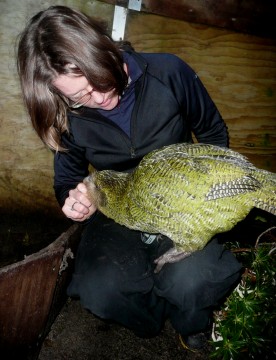Not just pandas
Blogger: Serial Bird of the Year campaigner and ex-Wellington zoo staffer, Stephanie Gray
—– Part I of a two-part blog about native species in New Zealand zoos —-
The hugely publicised arrival of an Emperor penguin to the Kapiti coast coupled with the rare opportunity to see this Antarctic native explains the throngs of people paying to see Happy Feet at Wellington Zoo.
Not long before this, besotted visitors queued at Auckland Zoo to see Sirocco, the kakapo made infamous with his televised seduction of Stephen Fry.
But how will little blue penguins, tui and (even further down the glamour charts), the banded kokupu compare with the kakapo and penguin’s rarity and celebrity when it comes to selling zoo tickets?
It’s a question that springs to mind as Auckland Zoo prepares to open its $16 million native flora and fauna exhibition at the end of the year.
Te Wao Nui is the largest project in the zoo’s 88-year history and involves the Department of Conservation and Ngati Whatua o Orakei as conservation partners.
Species will include the aforementioned penguins, tui and kokupu, as well as bellbirds, long-fin eels, short-tailed bats, morepork, cave weta and land snails.
Ian Fraser, curator of native fauna at Auckland Zoo, says that “some species are not as common, or appreciated as you might think”.
He’s got a point: people on the coast are more likely to recognise the squawks (and pungent odour) of little blue penguins swimming to nest after a day’s fishing than people who live inland. In Hamilton, tui are only just returning to gardens and parks.
Ian says that people don’t necessarily appreciate, or even notice, the birds in their ‘burbs until they know what they are.
“We will present tui and bellbirds and the eels as a special endemic species so that people notice and then recognise the birds in the wild. Familiarity is a good starting point for a greater appreciation of local biodiversity,” Ian says.
The concept of ‘advocacy animals’ also comes into play. The popularity of Happy Feet and especially Sirocco rationalises their role as advocates—captive representatives of a vulnerable species.
“In the zoo, we can advocate for lesser-known species such as the long-finned eel and make poster children of them,” Ian says.
The zoo will have to maintain its population of endemic and endangered long-fin eels by capturing wild eels. But as Ian comments wryly, the zoo eels are at least safe from the fish markets. By this he is referring to the anomaly (to put it mildly) that legalises the commercial harvest of our endemic and endangered eels.
Education and advocacy intentions are all very well, but a zoo by nature has to balance its conservation and commercial efforts. They need to get enough people through the gates to pay the bills and stay viable as a council controlled organisation, or a registered charity running a ‘not for loss’ model.
Are our native species enough of a draw-card?
Children are infatuated with chimps, big cats and giraffes. But will a powelliphanta land-snail – as beautiful as the amber, ancient mollusc is – enthral the four year old and secure repeat visitation?
Will the time-constrained cruise ship tourist take the time to try to spot banded kokupu through a pond surface? Or will they head straight to the red panda enclosure for a quick thrill?
Ian is convinced the accessibility of native species in zoos will prove to be popular amongst time-strapped wildlife lovers.
After all, the likelihood of spotting a short-tailed bat in the dark is slim compared to ogling clusters of bats in an enclosure under infrared lights. Giant weta litter the pathways on Matiu/Somes Island, but the ferry-ride and night-time excursion (fun!) might complicate things for parents.

